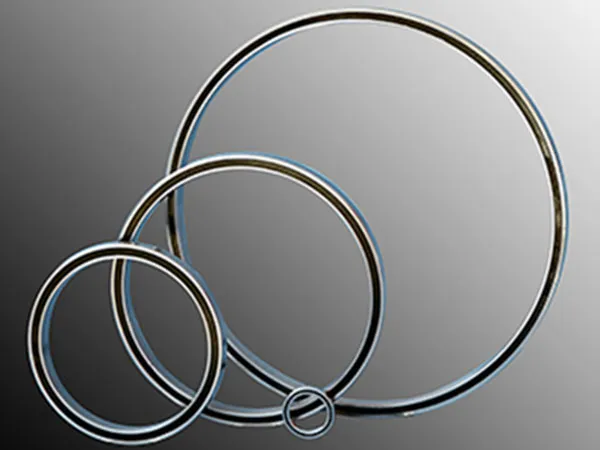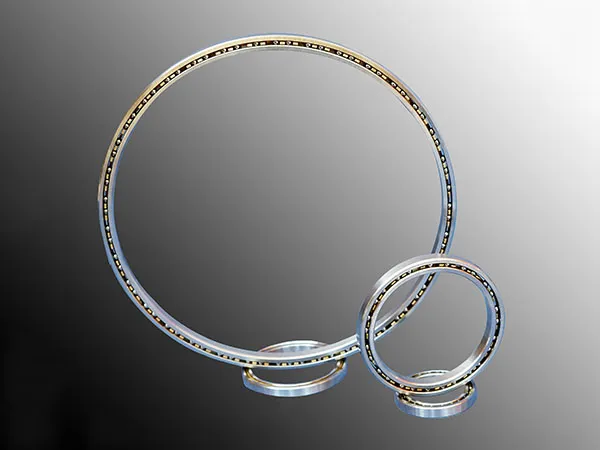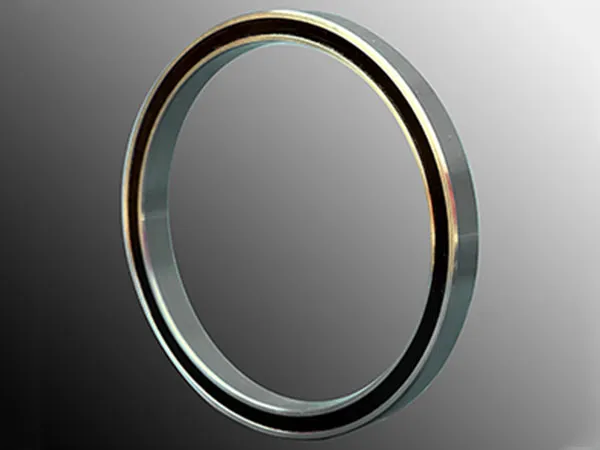The manufacturing process of thin section bearings is a complex and precision-driven endeavor, often more challenging than that of standard bearings due to their extremely thin cross-sections and precise tolerance requirements.

High-quality steel alloys are typically chosen for their strength, durability, and wear resistance. Common materials include chrome steel (100Cr6) and stainless steel (X65Cr13, 440C).
For demanding applications, specialized materials like high nitrogen steel (X30CrMoN15-1) for corrosion resistance or ceramic (silicon nitride) for balls (reducing friction and improving heat resistance) may be used.
Cage materials vary, including pressed steel, machined bronze, fabric-reinforced phenolic material, or high-performance plastics like PEEK or Polyamide-imide.
This is the initial step for creating the basic shape of the inner and outer rings.
For larger sizes and thin-section bearing rings with a small aspect ratio, a "combined forging" method is often used, where two or more blanks are forged together. After rough grinding, they are separated by wire cutting. This reduces processing difficulty, minimizes deformation, saves material, and improves efficiency.
The steel is typically heated to high temperatures (e.g., 1200 degrees Celsius), buckled, pierced, and milled.
Smaller rings might be cut directly from tubes or bars.
Once the basic ring blanks are formed, they undergo precision machining on multi-spindle lathes.
This step involves removing material to create the precise inner and outer dimensions, including the raceways for the rolling elements and grooves for seals.
Due to the thin cross-section and poor rigidity of thin-section bearings, clamping and positioning are critical to avoid deformation. Manufacturers often use specialized fixtures (e.g., multi-point clamping chucks with a large envelope circle contact area) and adjust cutting parameters (e.g., high-speed cutting, small back cutting amount, larger main deflection angle) to minimize machining stress, thermal deformation, and vibration.
An additional tempering process after rough turning may be applied to eliminate stress.
This crucial step enhances the strength, hardness, and wear resistance of the bearing components.
Parts are heated in a hardening furnace (e.g., to 800-830 degrees Celsius) and then rapidly cooled, or "quenched," by immersing them in a salt or oil bath.
During this process, the internal structure of the steel undergoes phase transformation (e.g., austenite to martensite), leading to volume expansion and internal stress.
Die quenching is often used to control deformation. If die quenching isn't feasible, methods like comprehensive shaping and tempering are used to correct excessive outer diameter deformation.

After heat treatment, the bearing components are ground to their precise final dimensions. This involves using specialized grinding machines and various grinding media.
The goal is to achieve extremely smooth and accurate raceway surfaces for optimal performance and minimal friction.
Multiple fine adjustments of the machine tool are often required for the outer diameter surface.
Tempering stabilization may be added during the process to ensure grinding quality.
The rolling elements (balls or rollers) are manufactured separately to precise dimensions and tolerances.
They are typically made from high-quality steel and may also undergo their own heat treatment processes to enhance hardness and durability.
Once all individual components (inner ring, outer ring, rolling elements, cage, seals/shields if applicable) are precisely manufactured, they are assembled in a controlled environment.
Precision assembly techniques are essential to ensure proper alignment and minimal internal clearance, which are critical for the bearing's functionality and smooth operation.
Bearings are lubricated with grease or oil to reduce friction, dissipate heat, prevent metal-to-metal contact, and protect against corrosion.
The type and amount of lubricant are carefully chosen based on the intended operating conditions and customer specifications.
Sealed bearings are typically supplied with grease, while unsealed bearings may be coated with oil.

The completed bearings undergo rigorous quality control checks to ensure they meet all required specifications for size, shape, precision (e.g., ABEC tolerances), and functionality.
This may involve testing the bearings under various load and speed conditions to verify their performance characteristics.
Deformation: The small cross-sectional area and thin radial wall thickness make the rings prone to significant radial deformation during machining and heat treatment.
Precision: Achieving the tight tolerances required for smooth operation and long service life is extremely challenging.
Clamping and Machining: The thinness makes proper clamping difficult without inducing stress or deformation, and machining parameters must be carefully controlled.
Despite these challenges, advancements in manufacturing techniques and materials continue to improve the production and performance of thin section bearings, making them vital components in applications where space, weight, and precision are paramount, such as robotics, aerospace, and medical equipment.
A Comprehensive Analysis of Slewing Bearing Manufacturing Process: Materials, Procedures, and Detailed Precision Machining Steps
2025-12-15 16:30How to Improve the Surface Brightness of Slewing Bearings? 5 Effective Methods to Enhance Performance and Durability
2025-12-11 15:36How Long Is the Service Life of Slewing Bearings? Key Factors That Determine Durability
2025-12-05 14:26Customized Precision Crossed Roller Bearings: Unlocking Maximum Industrial Performance
2025-11-24 10:45Address: Lianmeng Road, Jianxi district, Luoyang City,Henan province.
E-mail: info@lynicebearing.com
Phone: +86-379-60689957
If you are interested in our products and services,
please feel free to contact us!
Get in tuch

+86-379-60689957
Lianmeng Road, Jianxi district, Luoyang City,Henan province.